This Wednesday I experienced one of the most incredible evenings of nature photography ever. So to make up for a couple of missed blog posts this week, you get an extra-long post about a great experience: Rich and I saw a Sandhill Crane hatch!!! Sandhill Cranes make their nests in marshy habitat, typically in a small pond where the nest is surrounded by water. The water keeps predators from the eggs. Both parents incubate the nest in the daytime, but Mom gets the whole night shift. The babies are precocial, meaning that they are born with some ability to care for themselves. Several hours after hatching, they are able to walk (wobble), swim, and begin feeding. The eggs are laid 24-48 hours apart, so they hatch asynchronously, with one colt slightly older and feistier than the second. I had lots of time to read about the cranes during my nest watches, and I found this website really interesting. The Florida subspecies of Sandhill Cranes is threatened, so it was extra special to have this opportunity to view the birds up close.
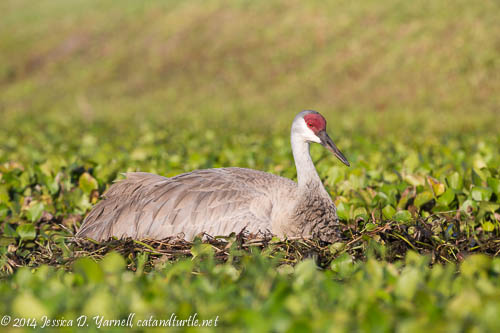
I’ve been watching this nest for four or five years. It’s in a small retention pond that I drive by every day. Last year, bad rains caused the nest to flood – twice! So this year as I secured permission to photograph at this property, I hoped and hoped that the rains would stay away. The birds went on eggs around March 10 (this pair tends to nest a little later than other area cranes, who often have colts by that time.) Sandhill Cranes incubate for 29-32 days, so my Hatch Watch started last Friday. I checked the nest regularly, imploring the weather to please let this year’s babies have a chance at survival. After Tuesday’s thunderstorms passed and the nest was still intact, I breathed a sigh of relief. Then on Wednesday afternoon, Rich and I spotted a baby. The first colt had hatched!!

I think the first colt hatched early Wednesday morning. He was already all dried off and fluffy, sunning himself on the top of the nest. The light was harsh, but my subjects were adorable. The first colt sat on the nest, next to his unborn sibling, while Mom stuck her head down to check on them both. Then I looked a little closer and realized that the egg had a hole in it. The second baby was trying to come out!
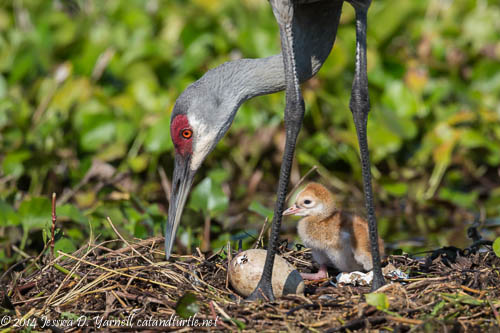
The hatch starts with a small hole, called a pip, in the egg. The unborn bird uses his beak to break through the egg. It’s not an easy task, and it can take hours. The last hatching I saw was a Snowy Egret, which took about three hours. Mom kept turning the egg to help the little guy break free.

I loved how the photo above shows Mom turning the egg, with her beak so close to the hatch hole. Then I blew up the photo and saw that I could clearly see the little guy’s beak coming out of the hole. How cool is that!? Here’s the enlarged version:
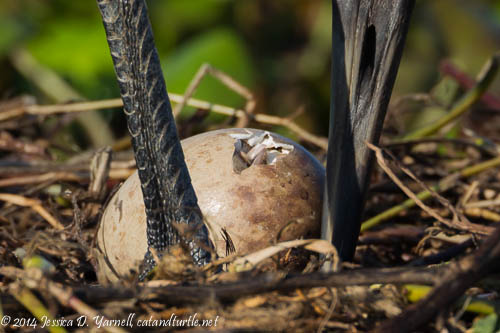
I also used the Beast to take a short video of the egg. At the time, I didn’t realize that I could so clearly see the beak coming through. I just saw motion coming from the hole that I tried to catch on video. I had left my tripod in the car, and I didn’t think to send my Filter Boy to go get it, so I tried to hold my breath and hold the Beast still, and then I used iMovie to reduce the camera shake. If it doesn’t make you nauseous (sorry about that!), the video does show the little guy’s beak as he breaks out of his egg. It was pretty cool. [vimeo id=”91759438″] At one point, Mom stuck her beak down into the hole, just for a second or two. It made me wonder why she didn’t help her little baby work its way out of the egg. Then again, I’ve read that the hatching is part of the survival of the fittest. If the chick isn’t strong enough to break through the egg, then he won’t be able to survive once he’s born. Mom was certainly attentive to the little guy, though, and she turned the egg repeatedly. I guess that’s her way of helping.

The older chick was off the nest for most of the afternoon. He wobbled his way down to the water, swam a foot or so, then fought his way through the thick pond vegetation to crawl up onto a grassy hill with Dad. I wonder if Dad wasn’t intentionally keeping him away from the hatching at the nest. He was adorable to watch as he waddled around, learning how to use his legs. Rich laughed every time he tumbled to the ground. He just got right back up and kept exploring!

Mom left the hatching egg on the nest for 15-20 minutes and went to stretch her legs on the hill. Both parents started feeding the older colt, and I had to laugh as they simultaneously tried to hand him an insect each. I bet it was his first feeding. The attention they paid to their colt was touching. I made another video, and this time iMovie did a great job at stabilizing the camera motion: [vimeo id=”91764349″] When Mom came back to the nest, she didn’t walk – she flew! It surprised me to see her fly the 5-6 feet, which she can easily cover in a couple of steps with those long legs. Then as I watched for longer, I realized that the nest is built on top of mud, and it shifted each time the cranes walked near it. If they took a wrong step, they sank part of the nest. So I guess it was safer to fly in and land squarely (and gently) on the center of the nest.

The world is a dangerous place for tiny colts, and even unborn eggs. Mom and Dad were constantly vigilant of everything that moved in the nesting area. At one point, Mom quickly hopped off the nest and splashed down into the adjacent water. It surprised me – she was leg-deep in water, which means the water was deeper than I thought! Both Mom and Dad were peering with great concern into the water, then Mom reached down to snatch something. She made a good splash. I never did see the cause of her concern, but she relaxed and so did Dad.
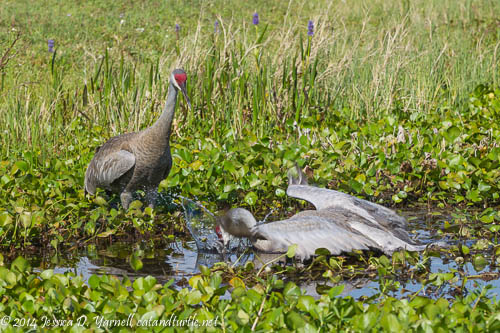
As the sun set, I realized that something special was happening with the egg. The hole had extended all the way around the top of the egg, and hatching was eminent. I dared the light to fade before I got a chance to welcome my little buddy into the world! :) Mom at this point was back on the nest, alternating turning the egg and brooding the egg. Each time she stood up, I got a better look at the emerging colt.

The wing (ok, the stub that will grow into a wing!) was the first to emerge from the egg. Rich and I did a little cheer when we saw it. “Come on, little guy, you can do it!” we said. We couldn’t believe we were getting to watch a Sandhill Crane hatch.

After the wing came the head. The baby had broken his hole across the top of the egg. In the shot above, you can see him wiggling to free his head. The whole time, he made the same little “peep peep peep” call that the little colts make to talk to their parents and siblings. Actually, I think I heard the little call coming from the egg hours before his head emerged, which coincides with what I’ve read about the parents and unborn chick communicating prior to hatching.

Then his head was free! Mom looked on as he lay resting, with his face down on the nest. You can see his little eyeball just above the “u” in my copyright. Mom continued poking at him and sitting on him. His big feet appeared as he continued to exit the shell. The next time Mom stood up, he made one last big effort to pick up his head, wiggle his front, and maneuver his back out of the egg. Welcome to the world, little one!
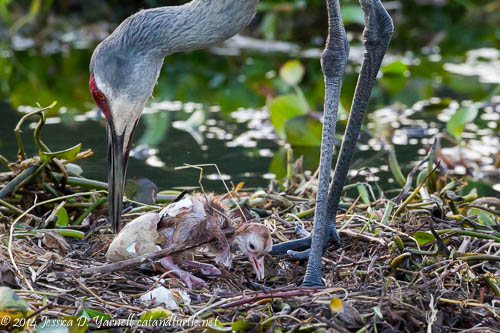
The first rule of nest photography is that there’s always one stick too many. In this case, the stick stretched over the baby’s back and head. It looks like it’s crushing him, but as he wiggled his way out of the egg, he just pushed the stick out of his way. It was fun to see how quickly the egg collapsed as its inmate took his first breaths.

Dad came over to the nest to say hello to his second baby. As the colt lay resting, both parents threw their heads back and started calling. If you’ve ever heard Sandhill Cranes on golf courses or in your neighborhood, you’ll know how loud their calls are. In this case, I think their message was, “It hatched! Baby Number 2 has Arrived! Hatch time 7:33pm, Mom and Baby are doing well!”

Dad had kept the older colt off the nest during the hatching. After the birth announcement, the older colt came squirming his way back onto the nest. Mom stood up when he arrived, letting him get a look at the new arrival. It’s easy to attribute human-like qualities to the animals that we admire, but it really looked as if she was saying, “Hi, honey, meet your baby brother.” Then Mom lay back down on the newborn colt. The older baby had a problem. He wanted to wiggle under Mom’s feathers, too, but he didn’t know how to get in! He spent a few minutes walking around his mom, trying to figure it out. Mom fluffed up her feathers to help him. He posed for a cute bedtime shot, then finally got himself under Mom’s wing. Good night, little ones!

As we left, Rich and I were giddy with excitement. We saw a Sandhill Crane hatch! It was so incredible!! Rich doesn’t often accompany me on my photo expeditions, since I tend to be a little boring, sitting in the same place photographing the same bird for hours on end. But Rich was there on this evening, and he was so excited to share in the joy of this hatching. He said he finally understood how I could sit for 12 hours watching my newborn swan cygnets last year. These moments spent with Nature are precious, and the last few days have been such a gift. You’ll get to read more in my next posts! Note: Please do not ask me where this nest is. It’s on private property, and I had to get special permission to photograph there. Thanks, Byron and Jeff!
Want to learn more about nature photography at Sandhill Crane Nest #2?
Check out my Sandhill Crane Nest #2 page with more information about the location, map, website, photography tips, etc. It is archived by date so you can see my images from previous visits. Maybe you'll be inspired for your own trip!
Planning a trip to Florida? Don't miss my Central Florida Bird Photography Locations reference guide!

8 thoughts on “Out of the Egg: I Saw a Sandhill Crane Hatch!!!”
What a great thing to see! Beautiful story and pictures. I’ve never seen them hatch.
Thanks, Dina! I never thought I’d get to see one hatch, either. Sometimes you just end up at the right place at the right time. :)
I am SO happy for you! What a beautiful, special, miraculous thing for you to have witnessed! So deserving…for it is always more than taking the photograph for you and your tender heart. Amazing images…. captivating story…. bravo. So well done. Big smiles….
Can’t wait to see you on the lake!
xo,
Kim
Thanks, Kim, I knew you’d like these, even if they aren’t cygnets! I can’t wait for hatching time on the lake. Tell the birds to time the hatchings for the weekend, haha! :)
Very, very cool! What a special treat to witness! Say Hi! to Filter Boy for me! :-)
This is the sweetest thing I’ve ever seen! Thank you for sharing it. :o)
WOW, Jess! What great photos. Amazing what you captured with the camera lens. Awesome!!
Perfect timing! And wonderful images, videos, and capture! I definitely need to move to Florida. It is raining here in northern Virginia with a cold front coming and with freezing temperatures predicted for tonight.
Comments are closed.